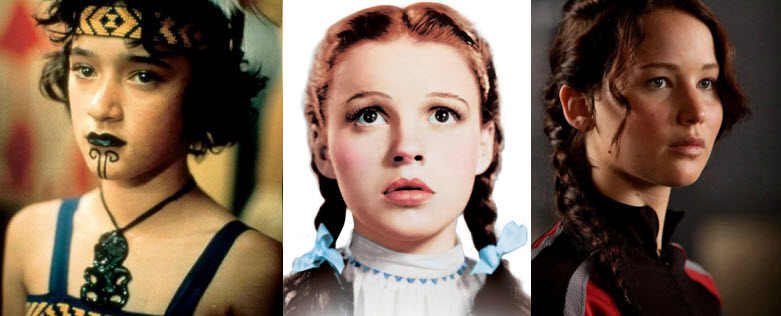It cannot be denied that females are underrepresented as main characters in the world of mainstream stories. Can we understand and fix that? You bet.

The Underrepresented Majority
It cannot be denied that females are underrepresented as main characters in the world of mainstream stories. A quick glance at the Oscar® nominations for the years 2013 and 2014, for example, reveals that of the 16 films nominated for Best Picture, only two (or three, if we’re being generous) featured female main characters. And the trend continues.
The causes of this imbalance are varied, historical, cultural, and perhaps even evolutionary—and are well worth addressing in scholarly books and college curricula. But to make significant inroads into redirecting the tide, it is necessary to go beyond scolding and to examine what makes a story slice through natural gender biases and appeal so strongly to human universals that its theme feels gender-neutral even though the skill set of its main character is clearly influenced by her chromosomal makeup.
Significant inroads to understanding and correcting the imbalance can be made by examining the human universals in story themes.
And yes, it's unfair that stories with male main characters don't seem to require the same sort of study to be considered potentially popular in the mainstream. But this article is not about what's fair and unfair. It's about understanding the role of the main character and her relationship to the story so well that you can perform a thematic sleight of hand and maximize the potential of the story to appeal to the broadest possible audience. (And it applies to stories with male main characters, too.)
Motivation in Three Movements
To understand the thematic impact of your main character and her journey in the story, it is necessary to explore her motivations and approaches to confronting the obstacles that present themselves in that journey. According to the principles presented in Discovering the Soul of Your Story, this is best done by starting with her type of intent—that is, the overarching focus of her efforts, which can be expressed in one of three ways: to gain, to regain, or to keep.
Simply put, a gain character intends to obtain something (for example, an object or condition) that she has never possessed, a regain character intends to recover something that she possessed at one time but lost or had taken away, and a keep character intends to retain something that is under threat of being lost or taken away. Of course, that's only the tip of the iceberg, but those are the three potent crystals that cause the iceberg to start growing in the first place.
To illustrate the impact of this kind of thinking, let's look at three strong female main characters each of whose journey illustrates one of the three types of intent—Paikea in Whale Rider; Dorothy Gale in The Wizard of Oz; and Katniss Everdeen in The Hunger Games. (These happen to all be teenagers, it's true, but the principles apply regardless of character age... which is a matter for another article.)
Paikea in Whale Rider (Gain)
In Whale Rider, the main character, Paikea, is a young Maori girl whose journey is driven by her desire to gain her proper place in the world, as leader of her tribe. To do so, she must struggle to defy the traditional/conventional views embodied in the character of her grandfather, Koro, whom she loves.
Paikea is a gain character whose treasure is a sense of being allowed to fulfill her destiny.
Because Paikea conducts her journey with honorable determination, it is easy to root for her to succeed—in part, because her success represents a blow against restrictive traditionalism and a beachhead established in favor of freedom. These are human universals that transcend her gender and age and speak to a large audience. The fact that she uses traits that can be reasonably ascribed to her age, gender, and culture to accomplish her goal simply lends richness and believability to her character; it does not require us-the-audience to identify directly with those characteristics to understand or become involved in the story.
And although the treasure that she attempts to gain is highly personal—a sense of being allowed to fulfill her destiny as custodian of the dignity of her tribe—it transcends gender by virtue of the fact that the sense of wanting to fulfill one's destiny is a human universal.
Dorothy Gale in The Wizard of Oz (Regain)
In The Wizard of Oz, the main character, Dorothy Gale, is a young Kansan whose journey is driven by her desire to regain her proper place in the world—that is, the farm and family environment from which she fled and then was magically whisked away by forces beyond her control. To return to Kansas, she must seek out a mighty wizard who might know how to help her, and then accomplish a great task that he sets for her in exchange for the help.
Dorothy is a regain character whose treasure is her proper place in world to which she belongs.
Although Dorothy is clearly in terra incognita with regard to her locale and mission, she approaches her journey with polite determination and uses her innate nice-ness to form alliances that aid in achieving her ultimate goal of returning to Kansas. And the idea of using one's innate skills to put right one's world when it is overturned—and doing so honorably—is a human universal, which is part of why the film is popular across genders, ages, and time. (The same can be said of another regain story, Back to the Future, in which the male main character, Marty McFly, finds himself thrown 30 years into the past.)
Katniss Everdeen in The Hunger Games (Keep)
In The Hunger Games, the main character, Katniss Everdeen, is a teenager whose journey is driven by her desire to survive (keep alive) in a brutal arena into which she is thrown by the powerful dystopian society that she inhabits. To do so, she must rely on her own physical and mental abilities and on her inner values of determination, compassion, and a sense of fairness.
Katniss is a keep character whose treasure is staying alive.
Like Paikea and Dorothy, Katniss approaches her mission with laudable honor, doing what she must do to survive while forming necessary alliances and protecting those who, like her, refuse to embrace the society that created the arena. And because she acts with selfless determination, we-the-audience are prone to root for her to succeed, in part because her success represents a flag thrust firmly into the high ground on behalf of those who believe in freedom and honorable living—which are human universals.
By virtue of her success in keeping alive, Katniss upsets the political apple cart of the society that sought to destroy her. But doing so is never her intent in the story; she's simply trying to keep alive and to keep her principles of honorable behavior intact against the temptation to abandon them for the sake of her survival.
Looking Forward
The gender inequity among mainstream main characters is not likely to end in the near future. But that doesn't mean its foundations can't be whittled away at and weakened and its stereotypes can't be x-rayed and exposed for what they are.
Doing so requires not only diligent dedication but a deep understanding of character motivations and how they relate to human universals that transcend gender, age, culture, and time. And the idea that any character arc can be considered a manifestation of one of three types of intent—to gain, regain, or keep—helps the writer to probe the depths of her story and develop that understanding.

For More Information
For details regarding the concepts and terms mentioned in this article, please refer to the resource materials.

0 Comments